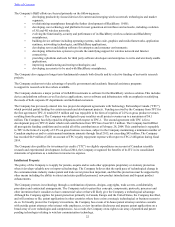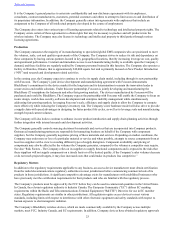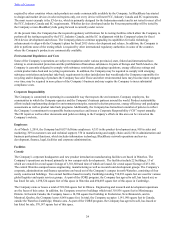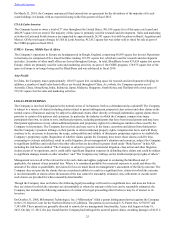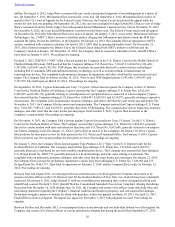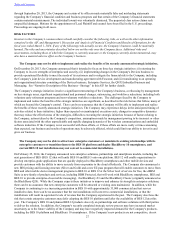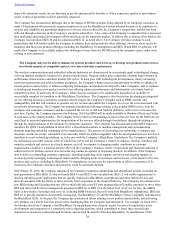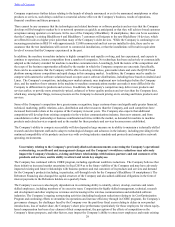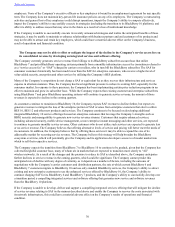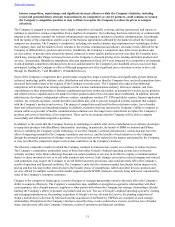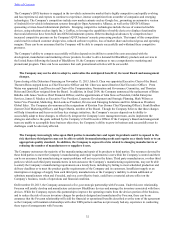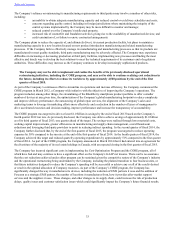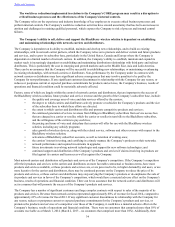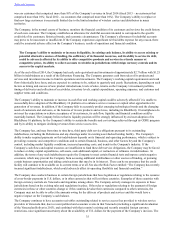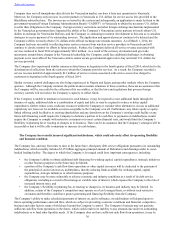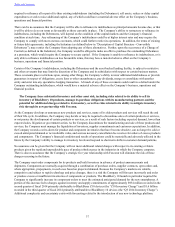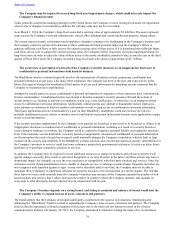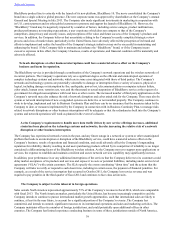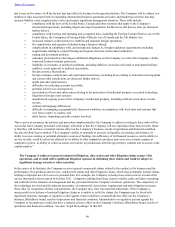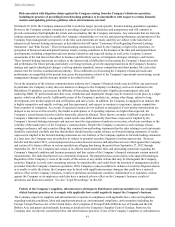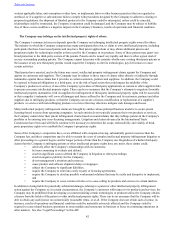Blackberry 2014 Annual Report Download - page 40
Download and view the complete annual report
Please find page 40 of the 2014 Blackberry annual report below. You can navigate through the pages in the report by either clicking on the pages listed below, or by using the keyword search tool below to find specific information within the annual report.
32
The Company's QNX business is engaged in the in-vehicle automotive market that is highly competitive and rapidly evolving
and has experienced, and expects to continue to experience, intense competition from a number of companies and emerging
technologies. The Company’s competitors include new market entrants such as Google Inc., promoting an automotive version
of Android for in-vehicle infotainment systems through its Open Automotive Alliance, as well as the GENIVI Alliance
sponsoring a Linux-based infotainment platform. Emerging competitive technologies include the use of connected mobile
devices, using solutions such as Apple Inc.’s CarPlay, to leverage the capabilities of mobile devices to displace functionality
that would otherwise have been built into OEM infotainment systems. Other technological advances by competitors have
increased competitive pressure on the Company's QNX business' acoustic processing products. The impact of this competition
could result in reduced customer design wins, reduced software royalties, loss of market share and reduced gross and operating
margins. There can be no assurance that the Company will be able to compete successfully and withstand these competitive
pressures.
The Company’s ability to compete successfully will also depend on its ability to control the costs associated with the
development, manufacture and marketing of new products. In order to drive demand for BlackBerry products and services in
the United States following the launch of BlackBerry 10, the Company continues to run a comprehensive marketing and
promotional program. There can be no assurance that such promotional activities will be successful.
The Company may not be able to adapt to, and realize the anticipated benefit of, its recent Board and management
changes.
Upon closing of the Debenture Financing on November 13, 2013, John S. Chen was appointed Executive Chair of the Board.
Thorsten Heins stepped down as Chief Executive Officer and Mr. Chen was named Interim Chief Executive Officer. Prem
Watsa was appointed Lead Director and Chair of the Compensation, Nomination and Governance Committee, and Thorsten
Heins and David Kerr resigned from the Board. In addition, in fiscal 2014, the Company announced the replacement of Brian
Bidulka with James Yersh as Chief Financial Officer, and the appointments of John Sims as President, Global Enterprise
Services, James S. Mackey as Executive Vice President, Corporate Development and Strategic Planning, Mark Wilson as
Senior Vice President, Marketing, Ron Louks as President, Devices and Emerging Solutions and Eric Johnson as President,
Global Sales. The Company also announced the resignations of Kristian Tear (former Chief Operating Officer), Frank Boulben
(former Chief Marketing Officer), and Roger Martin, member of the Board. Though the Company believes that these changes
will help it transition and focus on its three key strategic initiatives, the Company’s success depends on its ability to
successfully adapt to these changes, to effectively integrate the Company’s new management team, and to implement the
strategies and achieve the goals outlined by the Company’s Chief Executive Officer. If the Company’s Board and management
team are unable to accomplish these business objectives, the Company’s ability to grow its business and successfully meet its
challenges could be adversely affected.
The Company increasingly relies upon third parties to manufacture and repair its products and it is exposed to the
risk that these third parties may not be able to satisfy its manufacturing needs and repairs on a timely basis or to an
appropriate quality standard. In addition, the Company is exposed to risks related to changing manufacturers or
reducing the number of manufacturers or suppliers it uses.
The Company outsources the majority of the manufacturing and repair of its products to third parties. The resources devoted by
these third parties to meet the Company’s manufacturing and repair requirements is not within the Company’s control and there
can be no assurance that manufacturing or repair problems will not occur in the future. Third party manufacturers, or other third
parties to which such third party manufacturers in turn outsource the Company’s manufacturing requirements, may not be able
to satisfy the Company’s manufacturing requirements on a timely basis, including by failing to meet scheduled production and
delivery deadlines or to meet the product quality requirements of the Company and its customers. Insufficient supply or an
interruption or stoppage of supply from such third party manufacturers or the Company’s inability to obtain additional or
substitute manufacturers when and if needed, and on a cost-effective basis, could have a material adverse effect on the
Company’s business, results of operations and financial condition.
On December 20, 2013, the Company announced a five-year strategic partnership with Foxconn. Under this new relationship,
Foxconn will jointly develop and manufacture certain new BlackBerry devices and manage the inventory associated with those
devices. While the Company expects this partnership to improve the operating results from the devices portion of the business,
and to reduce the risk of excess inventory charges for products designed and manufactured by Foxconn, there can be no
assurance that the Foxconn relationship will yield the financial or operational benefits described over the term of the agreement
as the Company will maintain relationships with other EMS partners and has not previously had any experience in conducting
these types of arrangements with Foxconn.
Table of Contents


